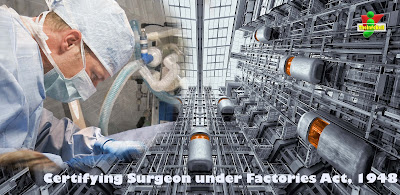Elaborate the Health measures that have been taken by the Factories Act, 1948
 |
| Health safety and welfare provisions under Indian Factories act,1948|Law notes |
INTRODUCTION
"Health is wealth" this is a common phrase, yet very true in every sphere of life. Healthy life is the key to a long life. In fact, health may be treated as a basic necessity of the mankind including those who work in the hazardous processes of a factory. A factory is a manufacturing unit which involves many hazardous processes and dangerous occupation. Therefore, there should be some special care for the factory workers in respect of their health, so that they do not have to forego a precious life for the sake of serving in the factory. All the matters of factories are dealt with by the Factories Act, 1948. And Health is an important chapter encoded in the Factories Act, 1948.HEALTH
Health is a physical as well as mental well being or a condition of body or mind in which a person is free from any diseases and under which a person is able to carry on his or her regular activities normally and usually. The Factories Act, 1948 does not provide any clear meaning or definition of health, but enumerates different provisions in Chapter - III from sections 11 to 20. These sections scope such a working environment in the factory which ensures the preservation of the health of the workers.MEASURES FOR HEALTH
Chapter - III provides for different measures that are ancillary to the good health of the workers. The legal provisions are discussed in simple language as follows:(i) Cleanliness (Section 11)
Cleanliness is an essential condition to maintain healthy conditions. Therefore, section 11 requires the factories to maintain cleanliness. The factories must be kept clean and free from pollute air. In order to maintain cleanliness, daily sweeping of floors and benches is compulsory to keep away the accumulation of dirt and refuse. Once in a weak, the floor must be cleaned by washing using a disinfectant.
(ii) Disposal of wastes and effluents (Section 12)
Section 12 provides that (1) Effective arrangements shall be made in every factory for the treatment of wastes and effluents due to the manufacturing process carried on therein, so as to render them innocuous, and for their disposal.
(2) The State Government may make rules prescribing the arrangements to be made under sub-section (1) or requiring that the arrangements made in accordance with subsection (1) shall be approved by such authority as may be prescribed.
(iii) Ventilation and temperature (Section 13)
The factories are bound to make effective and suitable provisions for securing and maintaining adequate ventilation by circulation of fresh air and a comfortable and healthy temperature. The state government may prescribe a standard for the purpose of Ventilation and temperature. The Chief Inspector also may serve on the occupier to take measures for the reduction of high temperatures.
(iv) Dust and fume (Section 14)
Section 14 of the Act provides for the prevention of accumulation of dust and fume and another impurity. If dust or fume or other such impurities are generated in the manufacturing processes, measures shall be taken to prevent its inhalation and accumulation. For this purpose exhaust appliances may be applied if necessary. In any factory no stationary internal combustion engine shall be operated unless the exhaust is conducted into the open air, and no other internal combustion engine shall be operated in any room unless effective measures have been taken to prevent such accumulation of fumes.
(v) Artificial humidification (Section 15)
Section 15 lays down the provision for artificial humidification. When any factory increases the humidity artificially, the state government may make rules prescribing the standards of humidification, regulating the methods of such artificial humidification, directing prescribed tests for this purpose and prescribing methods for this purpose.
(vi) Over-crowding (Section 16)
No room in any factory shall be overcrowded to an extent injurious to the health of the workers employed therein. Factories built before the commencement of the Factories Act, 1948, must allow a space of 9.9 cubic meters for every worker. Similarly, factories built after the commencement of this Act shall allow a space of 14.2 cubic meters space for every single worker.
(vii) Lighting (Section 17)
There must be provision and maintenance for sufficient and suitable lighting, natural and artificial, or both, in every factory. The windows and skylight used for lighting purposes shall be kept clean from both inside and outside.
Further, the factories shall prevent glare from a source of light or reflection from a smooth or polished surface. It also prevents the formation of shadow which may cause eye strain or posses a risk of an accident.
(viii) Drinking water (Section 18)
The factories shall have to make an effective arrangements for a sufficient supply of wholesome drinking water. It may be provided at suitable points where it will be easily available for the workers. All such points shall be legibly marked "drinking water" in an understandable language by the majority of the workers. In every factory wherein more than two hundred and fifty workers are ordinarily employed provision shall be made for cool drinking water during hot weather by effective means and for distribution thereof.
(ix) Latrines and urinals (Section 19)
Every factory must accommodate the prescribed types of latrines and urinals conveniently situated and accessible to the workers. Latrine and urinal facilities must be provided separately for men and women. These latrines and urinals must be ventilated and adequately lighted. Unless permitted by the Chief Inspector, they must situate separate from the workroom. In factories having more than two hundred and fifty workers, there must be prescribed sanitary type latrines and urinals. The state government is empowered to make rules regarding latrines and urinals.
(x) Spittoons (Section 20)
Spittoons are to be provided in sufficient numbers in convenient places of the factory. Spittoons provided to the workers must be maintained in a clean and hygienic condition. The concerned state government may make rules for prescribing the type and numbers of spittoons and relating to other matters. The persons working inside the factory shall be required to spit only in the spittoons. A notice under the factory shall be displayed at suitable places for the provisions of spittoons and penalties for violation.











